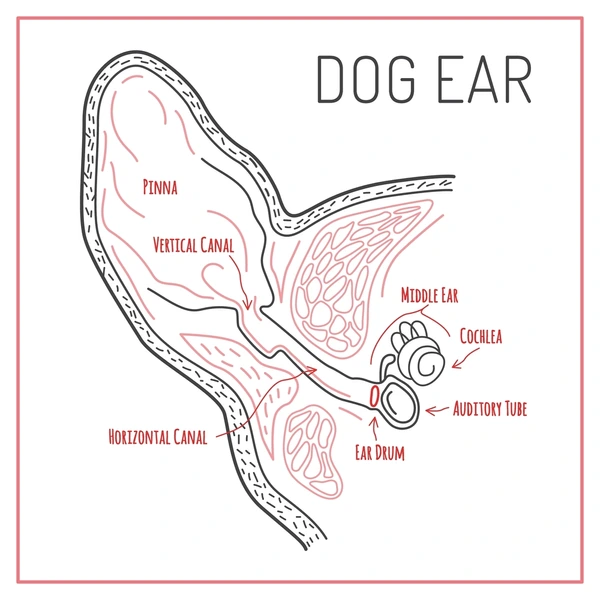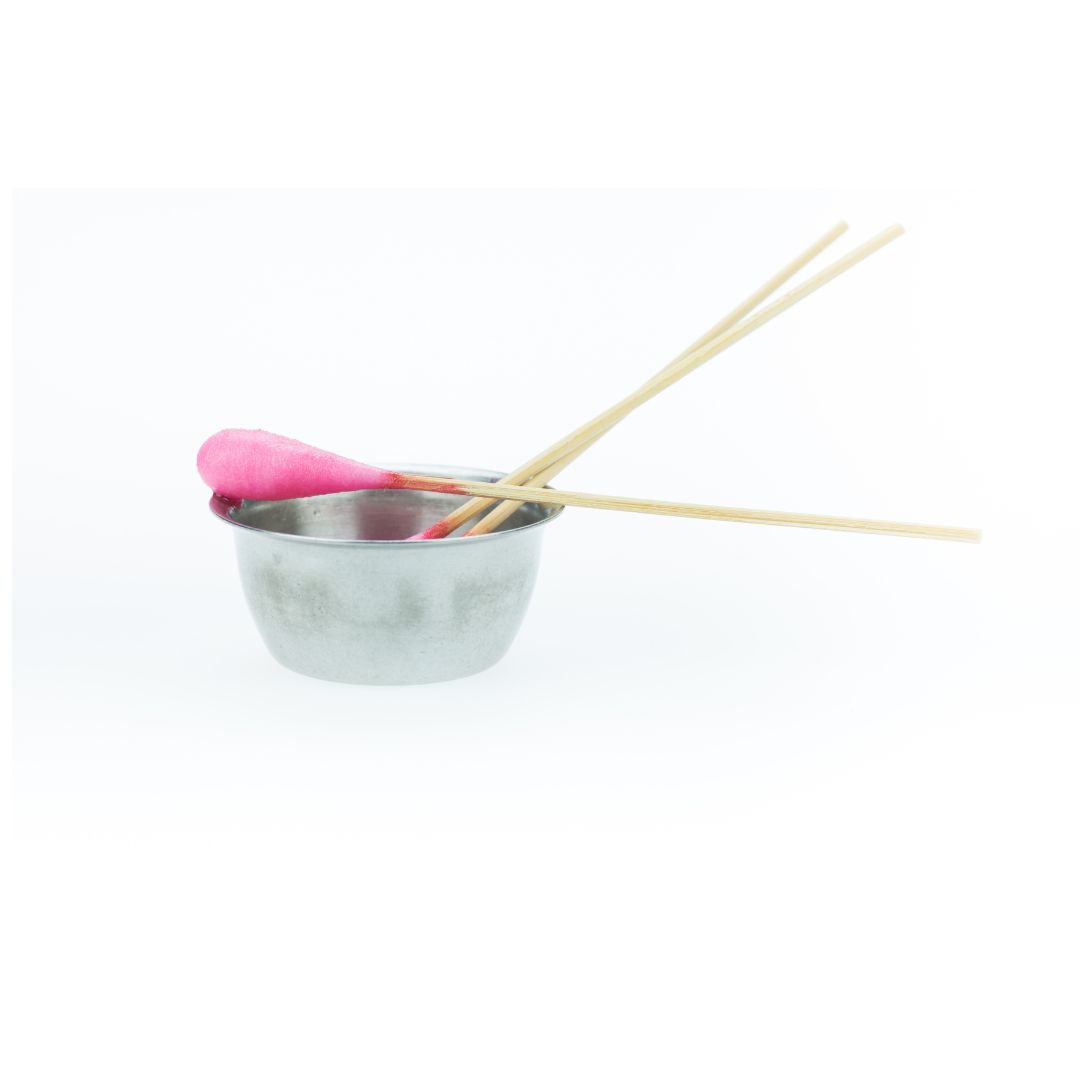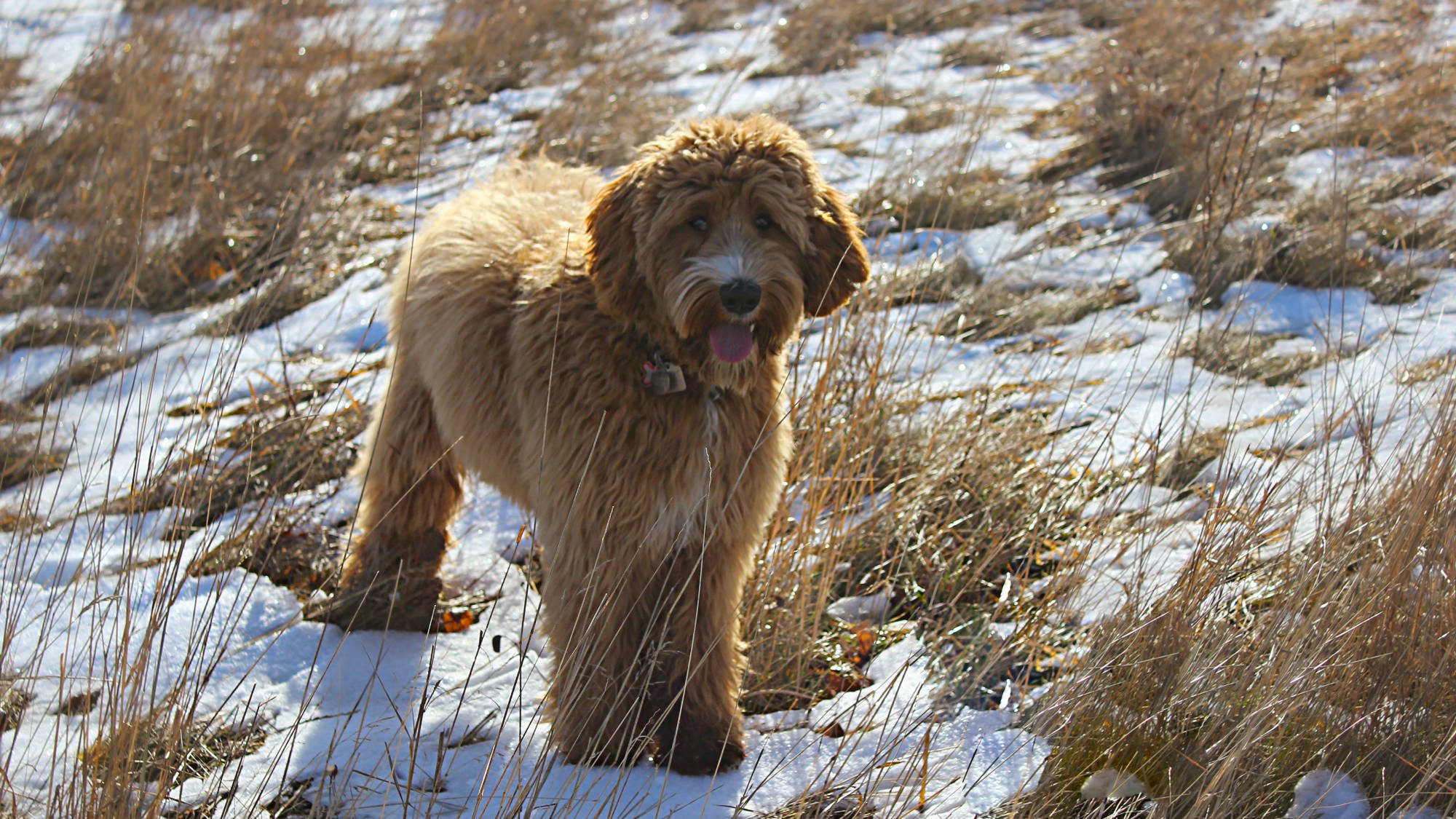Caring for your dog’s ears is a key part of their health routine that ensures they stay happy and comfortable. Regular ear check-ups and cleanings, along with spotting early symptoms of ear issues, are effective ways to prevent problems from worsening.
Table of Contents
- Dog Ear Health
- Dog Ear Infection Yeast vs Bacterial
- Signs of Ear Infection in Dogs
- Signs of a Yeast Ear Infection in Dogs
- 3 Holistic Remedies for Your Dog’s Ear Infection
- When Home Remedies Aren’t Enough
- Keep Your Dog’s Ears Healthy
Dog Ear Health
Understanding your dog’s ear health is helpful for providing proper care and preventing common issues. Dog ears have an L-shaped structure, making them prone to trapping moisture, debris, and promoting bacterial and yeast growth. Floppy-eared breeds, like Australian Labradoodles, may face increased risks due to poor air circulation.
A dog’s ear is divided into three main parts:
- External Ear: This is the visible part of the ear and includes the ear flap (pinna) and the ear canal. The ear flap helps direct sound waves into the ear canal.
- Middle Ear: This part is located between the eardrum and the oval window of the inner ear. It contains the three small bones (ossicles) called the malleus, incus, and stapes, which transmit sound vibrations.
- Inner Ear: This part contains the cochlea, which is responsible for converting sound vibrations into nerve signals sent to the brain. It also includes the vestibular system, which contributes to balance and spatial orientation.

Regular checks for signs of infection, such as redness, foul odors, and excessive scratching, are crucial. Additionally, dogs with allergies or those frequently exposed to water, such as swimmers, may be more susceptible to ear problems.
Maintaining clean ears, recognizing early symptoms, and implementing preventive measures contribute to your dog’s overall well-being. By understanding the unique anatomy of your dog’s ears and potential risk factors, you can take proactive steps to keep their ears healthy and prevent discomfort.
Dog Ear Infection Yeast vs Bacterial
Dog ear infections can be caused by yeast or bacteria, and it’s important to know the difference to treat your pet correctly.
Yeast infections usually produce a noticeable smell and a brown, sticky discharge. Dogs might scratch their ears more often and shake their heads.
Bacterial infections, on the other hand, might cause redness, swelling, and a bad odor, with a more watery or pus-like discharge.
Recognizing these signs can help you seek the right treatment from a vet, ensuring your furry friend gets relief quickly.
Signs of Ear Infection in Dogs
When suspecting an ear infection in dogs, look out for these key signs:
- Frequent scratching of the ear area or rubbing it against surfaces.
- Shaking the head vigorously as if trying to remove something.
- Redness or swelling inside the ear, making it look irritated.
- Discharge from the ear, which could appear yellow, brown, or even bloody.
- Bad odor emanating from the ear, a telltale sign of infection.
- Pain or discomfort, noticeable when the dog whimpers or pulls away if the ear is touched.
- Irritability or changes in behavior, as the discomfort can affect their mood.
Noticing these signs early can help in seeking timely veterinary care, ensuring your dog gets the relief and treatment needed.
Signs of a Yeast Ear Infection in Dogs
Canine ear yeast infections can manifest through a variety of signs and symptoms, often indicating discomfort for your furry friend.
- Persistent itching and scratching of the ears.
- Frequent head shaking or rubbing ears against surfaces.
- Increase in earwax production, often dark and resembling coffee grounds.
- Unpleasant odor from the ears, indicating yeast overgrowth.
- Redness and inflammation in the ear canal.
- Waxy or greasy discharge from the ears.
- Sensitivity or pain when ears are touched.
If you notice these signs, address the issue promptly through proper ear cleaning and treatment. Regular observation and preventive measures will contribute to the overall ear health of your canine companion.
3 Holistic Remedies for Your Dog’s Ear Infection
Here are some holistic and homemade Canine Yeast Infections Treatment recipes using natural ingredients to maintain your dog’s ear health.
1. White Vinegar and Green Tea Ear Cleaning Solution
The white vinegar and green tea solution is a gentle and natural way to clean your dog’s ears. Regular use of this solution can help maintain clean ears and prevent common ear issues.
Ingredients:
- 1 cup of green tea (cooled)
- 2 tablespoons of white vinegar
Instructions:
- Brew a cup of green tea and allow it to cool to room temperature.
- Mix 1 cup of green tea with 2 tablespoons of white vinegar in a clean bowl.
- Ensure that the solution is well-mixed.
Application:
- Using a clean syringe or a dropper, draw up 5 ml of the solution for every 20 pounds of your dog’s body weight.
- Gently lift your dog’s ear flap and squeeze the solution into the ear canal.
- Massage the base of the ear for about 20 seconds to help the solution reach deeper into the ear.
- Allow your dog to shake their head, which helps to remove loosened debris.
- Using cotton balls or pads, gently wipe the visible parts of the ear to clean any debris that comes out.
Note:
- Do not insert anything into the ear canal, and avoid using this solution if your dog has open wounds or sores in the ears, as it may cause discomfort.
- If your dog shows signs of irritation or discomfort, discontinue use and consult with your veterinarian.
2. Healing Oils Mixture
The healing oils solution for dog ears is a soothing mixture that can be beneficial for inflamed ears. This healing oil mixture can provide relief for inflamed ears and contribute to overall ear health.
Ingredients:
- 1 tablespoon of olive oil
- 1 capsule of Vitamin E
Instructions:
- In a small bowl, mix 1 tablespoon of olive oil.
- Puncture a Vitamin E capsule and squeeze the contents into the bowl with the olive oil.
- Thoroughly mix the ingredients to create a homogeneous solution.
Application:
- Using a clean syringe or a dropper, draw up a small amount of the healing oils mixture.
- Gently lift your dog’s ear flap and apply the solution into the ear canal.
- Allow the solution to soak in the ear for about 5 minutes.
- After the soaking period, massage the base of the ear to help distribute the mixture.
- Use a clean cotton ball to wipe away any excess solution and debris from the ear.
Note:
- Ensure that the solution is at room temperature before application.
- Do not insert anything into the ear canal, and avoid using this solution if your dog has open wounds or sores in the ears.
- If your dog shows signs of irritation or discomfort, discontinue use and consult with your veterinarian.
3. Natural Ear Mite Killer with Castor Oil
Castor oil is considered a natural remedy that may help with ear mites due to its properties. While castor oil is considered a safe and natural option, it’s essential to monitor your dog’s reaction.
Ingredients:
- Castor oil
Instructions:
- Ensure that the castor oil is at room temperature.
- Using a clean dropper or a syringe, draw up approximately 10 drops of castor oil.
Application:
- Gently lift your dog’s ear flap to expose the ear canal.
- Apply the 10 drops of castor oil directly into the ear canal.
- Massage the base of the ear for about 20 seconds to help distribute the oil.
- Allow your dog to shake their head, which can help remove debris and excess oil.
Note:
- Use this treatment twice daily for 7 days, then give your dog a break for 7 days before resuming for another 7 days if necessary.
- If your dog shows signs of irritation or discomfort, discontinue use and consult with your veterinarian.
- Be cautious when applying any substance to your dog’s ears and avoid inserting anything into the ear canal.
When Home Remedies Aren’t Enough
While homemade remedies can be effective for routine ear care and minor issues, there are scenarios where they may not be sufficient, and additional steps or professional intervention are necessary. Here are some scenarios that may require extra attention:
- Persistent or Worsening Symptoms: If your dog’s ear issues persist or worsen despite consistent application of homemade remedies, it indicates that the underlying problem may be more severe or complex.
- Intense Discomfort or Pain: If your dog shows signs of intense discomfort or pain, or if they resist or react negatively during the application of homemade solutions, it’s crucial to discontinue use and consult with a veterinarian.
- Bleeding or Open Wounds: If there are signs of bleeding, open wounds, or sores in the ears, homemade remedies may exacerbate the issue. Professional evaluation is necessary to prevent further complications.
- Foul Odor Persists: If a foul odor persists despite treatment, it could indicate a deep-seated infection or an issue that requires specific medical attention.
- Head Tilt or Balance Issues: A persistent head tilt or noticeable balance issues may suggest a more serious problem affecting the inner ear. This requires immediate veterinary assessment.
- Behavioral Changes: If your dog exhibits behavioral changes such as increased lethargy, loss of appetite, or changes in overall demeanor, it may indicate a more systemic issue that needs professional diagnosis.
- Recurring Ear Infections: If your dog experiences recurrent ear infections, it may be a sign of an underlying health condition or an incomplete resolution of the initial problem. Veterinary investigation is necessary for a comprehensive diagnosis.
- Foreign Objects or Tumors: Homemade remedies may not address issues like foreign objects lodged in the ear canal or the presence of tumors. These require professional examination and potentially specialized treatments.
- Allergic Reactions: If your dog exhibits signs of an allergic reaction to any homemade solution, such as swelling, redness, or hives, cease use immediately and seek veterinary advice.
- Chronic Conditions: Chronic conditions like allergies, autoimmune disorders, or hormonal imbalances may contribute to persistent ear problems. These require veterinary management and ongoing care.
If you encounter any of these scenarios or have concerns about your dog’s ear health, it is advisable to consult with a veterinarian promptly. Professional guidance ensures an accurate diagnosis and appropriate treatment plan tailored to your dog’s specific needs, addressing the root cause of the issue for long-term health and well-being.
For convenient access to licensed veterinarians who can diagnose and treat ear infections from the comfort of your home, consider Dutch, an online veterinarian service that also ships prescription medications directly to you. They have a Dog Ear Health page where you can learn how Dutch can help with your dog’s ear infections.
Keep Your Dog’s Ears Healthy
Taking care of your dog’s ears is an important aspect of their overall care. Regularly checking and maintaining their ears helps prevent issues, keeping your furry friend comfortable and happy. Understanding the signs of ear issues, such as infections and yeast overgrowth, empowers dog owners to initiate effective home remedies. However, it’s essential to recognize when home remedies are not enough, and professional veterinary care is needed. By staying observant of the signs of ear problems and acting swiftly, you can help keep your dog’s ears in good condition, contributing to their happiness and quality of life.








